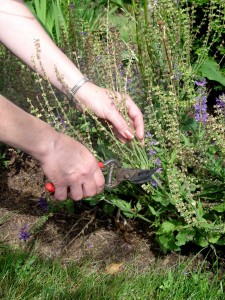Whipping the Yard Back Into Shape
September 4th, 2012
Now that the worst of summer heat should be over (risky words, I know), now’s a good time to freshen up the yard for fall.
Fall is my second favorite time in the landscape. But it takes a little bit of clipping, weeding and replanting to make that happen.
Now’s when a lot of people look at the yard and see an overgrown, browned-out, flopping mess. That tempts them to do one of two things: either shear and brutally whack the whole place or just stay inside and not look out.
I go with Option 3: an outdoor version of a good house-cleaning. I had some extra motivation to get that done over the weekend because our yard is on the Penn-Cumberland Garden Club’s “September Song” tour this Saturday (https://georgeweigel.net/georges-talks-and-trips).
My wife and I spent much of Labor Day just yanking weeds that somehow managed to sprout despite the super-hot weather. It seemed like a worse weed year than usual to me. What didn’t help in my case was putting down a mulch of leaf compost from the township last fall and forgoing mulching in the spring.
I usually try to keep about an inch of wood or bark mulch over my beds to hold down weeds and conserve moisture. That’s getting harder both time-wise and back-wise, so I’ve been trying to spread out the work between spring and fall. When I went to put down mulch last fall, the township was out of wood mulch. So I went with the leaf compost instead.
This is great stuff… about the texture of dark, fine soil. But it works much better as an amendment dug into garden soil as opposed to a mulch on top. I think the weeds actually appreciated the topping of compost.
Anyway, the yard looks a lot better just having the weeds cleared out and tossed in my compost pile.
We then staked up some of the flopping perennials (not as effective as staking them before they flop but better than doing nothing) and clipped the browned-out flowers off the summer bloomers (both perennials and flowering shrubs).
There’s a big difference between dead-heading and pruning. Dead-heading removes spent flowers while pruning removes leaves, stems and branches.
Fall is actually the worst time to do heavy pruning of woody plants. You’ll either cut off the forming flower-bud wood of next spring’s bloomers or encourage new growth at a time of year when plants are starting their annual slide into dormancy. End of winter through early summer are far better times to do most pruning.
I didn’t do any size-control pruning of anything over the weekend. All of the cutting was either things like snipping the browned flowers off the butterfly bushes and cannas or doing some very light tip pruning to slightly neaten a few things that were hanging too far into something else.
Some people like the plant intermingling that happens this time of year. I’m OK with some of that, but when two things collide more than mingle, that’s when I step in with my “referee pruners.”
One other thing that made things look much better — a fresh weed-whacking of the bed edges to neaten the lines between grass and gardens. A coat of mulch would be the coup de grace, but I don’t have the time or energy to do that right now.
What we did do was tuck in a few new plants to fill some bare gaps and empty spots where there’s not much going on.
Mums are the easiest, quickest fix. I also bought a few annuals for fall color, such as some purple pansies, a ‘Calico’ variegated hot pepper and a couple of white euphorbias that were on sale.
We also snuck a couple of porch pots into the garden gaps. Voila! Instant flowers.
It definitely looks a lot better. I’m happy that the stage is set now for my existing plants to start taking on their fall colors in another few weeks… assuming it doesn’t go back up into the 90s in October.









